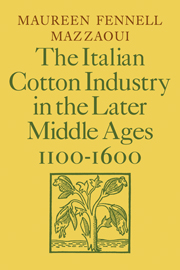Book contents
- Frontmatter
- Contents
- List of illustrations
- Preface
- List of abbreviations
- Map
- Introduction
- PART ONE THE ROLE OF COTTON IN THE MEDITERRANEAN ECONOMY
- PART TWO THE ORGANIZATION OF THE NORTH-ITALIAN INDUSTRY
- 3 The spread of cotton manufacture
- 4 Technological innovation
- 5 The structure of demand: products and markets
- 6 Guild and entrepreneurial structures
- PART THREE THE GROWTH OF COTTON MANUFACTURE NORTH OF THE ALPS
- APPENDICES
- Notes
- Select bibliography
- Index
3 - The spread of cotton manufacture
Published online by Cambridge University Press: 05 March 2012
- Frontmatter
- Contents
- List of illustrations
- Preface
- List of abbreviations
- Map
- Introduction
- PART ONE THE ROLE OF COTTON IN THE MEDITERRANEAN ECONOMY
- PART TWO THE ORGANIZATION OF THE NORTH-ITALIAN INDUSTRY
- 3 The spread of cotton manufacture
- 4 Technological innovation
- 5 The structure of demand: products and markets
- 6 Guild and entrepreneurial structures
- PART THREE THE GROWTH OF COTTON MANUFACTURE NORTH OF THE ALPS
- APPENDICES
- Notes
- Select bibliography
- Index
Summary
The history of the Mediterranean cotton trade provides a basic framework for the study of the spread of cotton manufacturing in medieval Europe. A viable commercial apparatus which permitted the cheap transport of bulky raw materials was a primary prerequisite for the establishment of the industry. However, the successful development of cotton manufacture also depended upon an assimilation of foreign technology, the creation of new markets and the adoption of an effective system of large-scale production. Following the opening of new trade connections to the Levant, there were several limited attempts to introduce the techniques of cotton weaving in various parts of Europe. In the twelfth and thirteenth centuries the processes of cotton manufacture first took firm root in northern Italy which alone provided the essential conditions for the growth of an export industry geared to the mass production and marketing of cheap textiles. Together with silk and woolen production, cotton manufacturing contributed significantly to the prosperity of the north-Italian towns at the height of their economic expansion.
The importance of cotton manufacturing in the north-Italian economy has often been underestimated. In contrast to wool, both cotton and silk were ‘transplanted’ industries which were a direct outgrowth of expanding commercial contacts in the Mediterranean. Silk manufacture, which involved the greatest complexity in products and processes, developed very slowly before the fourteenth century. Its labor force was relatively small and almost entirely composed of urban craftsmen.
- Type
- Chapter
- Information
- Publisher: Cambridge University PressPrint publication year: 1981



